Exclusive: Understanding Load Factor Implications for Specifying Onsite Generators
Maximum permitted average load factor varies depending on the generator set's rating, the specific application and the manufacturer's recommended guidelines.
By Brandon Kraemer, Application Engineering Supervisor, MTU Onsite Energy Corporation
One of the important steps in sizing generator sets for any application is to determine the application's average load factor. Understanding this parameter is essential not only for proper power system sizing but also for operability and reliability.
ISO-8528-1 limits the 24-hour average load factor on most standby generator sets to 70 percent of nameplate capacity. For utility outages lasting a few minutes or a few hours, one or two times a year, standby generator sets are designed to be loaded to 100 percent of nameplate capacity for the duration of the outage. However, if an outage lasts days instead of hours and the standby power system is loaded to 100 percent of its nameplate capacity, it is likely that the 24-hour average load will exceed the power system's design parameters.
While running a generator set at an average load factor over 70 percent is unlikely to result in a catastrophic failure of the standby power system, it may jeopardize engine warranties, reduce reliability and shorten the useful life of the generator-drive engines. It may also jeopardize the operation of mission-critical facilities where load factors are often high and constant. This paper reviews the concept of average load factor and the calculations used to determine an application's average load factor. It also suggests strategies to ensure backup power availability during extended utility outages and in applications with minimal load profile variability.
Average load factor
The average load factor of a power system is determined by evaluating the amount of load and the amount of time the generator set is operating at that load. Since the loads are normally variable, the result is found by calculating multiple load levels and time periods. See Figure 1 for a graph of a hypothetical standby load profile:
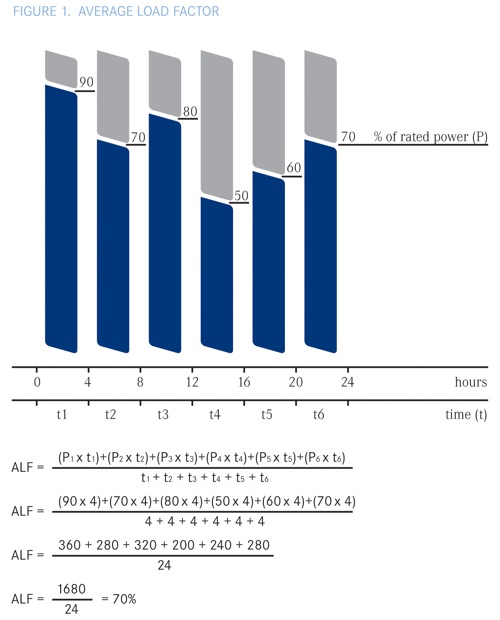
In Figure 1, the 24-hour average load factor is derived from the formula shown under the graph, where P is power in kW and t is time. You can see that although the generator set is loaded to 90 percent of its standby rating for a portion of the time, the average load factor over time is only 70 percent, due to the natural variability of the building load. In practice, it would be unlikely that a standby power system would be initially sized so small as to require operating at 100 percent of capacity at any time during an outage. However, electrical loads are often added, and growing power needs may begin to tax the capacity of a standby power system. Note: any time that the generator set is offline does not count towards the 24-hour average load factor.
High mission-critical load factors
For most facilities with properly designed emergency standby power systems, the possibility of exceeding a power system's 24-hour average load factor limitation is remote. This is because most commercial facilities have variable load profiles that reduce the likelihood a power system's 24-hour average load factor limitation will be exceeded, even during an extended outage. Many facilities also have noncritical loads that can be taken offline during extended outages to reduce the average load factor on the standby system, if necessary.
However, many mission-critical facilities have large, less varying loads that can severely stress standby power systems during an extended power outage unless steps are taken during system design to accommodate the potential for a higher average load factor. Two examples of mission-critical facilities with high load factors are data centers and semiconductor manufacturing. In data centers, the computer servers and HVAC equipment create high electrical loads that can vary little over time. Similarly, very high load factors are found in semiconductor foundries, where electric furnaces cannot be shut down without destroying large amounts of product.
As a result of these large, steady electrical loads, the load profile in a mission-critical application is likely to have less variability, in turn putting a more constant demand on the standby power system. Less load variability results in a higher average load factor that will require either: 1) specifying a system with larger or more generator sets capable of a
70 percent load factor; or 2) specifying generator sets capable of higher than a 70 percent load factor.
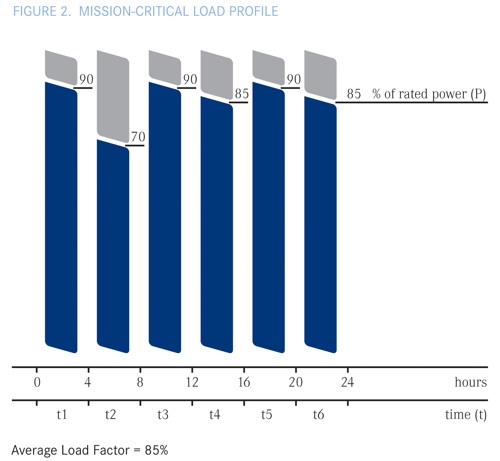
In Figure 2, you can see that while the generator sets are not loaded to 100 percent of their standby rating at any time, the average load factor during the outage is near 85 percent. In this case, the customer has taken advantage of generator sets capable of an 85 percent load factor that can deliver more than 20 percent additional kilowatts than generator sets rated to only a 70 percent average load factor.
Defining standards for generator sets
Standards that apply to all generator sets are those established by the International Organization for Standardization (ISO). ISO defines how to measure and rate many quality and performance parameters. All major generator set manufacturers utilize this standard to communicate their generator set ratings to their customers. In particular, ISO 8528-1 describes how to establish generator set ratings, measure performance and evaluate engines, alternators, controls and switchgear.
ISO-8528-1 sets a maximum 24-hour average load factor capability of 70 percent for both standby- and prime-rated generator sets, unless a higher average is agreed to by the engine manufacturer. This means that a 3,000 kW generator set meeting this standard must be able to provide an average of 2,100 kW per hour over a 24-hour period. In emergency standby applications, this means that the average load factor that can be sustained by most generator sets over an extended outage of 24 hours or more can not exceed 70 percent of the nameplate standby rating, a factor that affects generator set sizing.
In contrast, MTU Onsite Energy allows an 85 percent average load factor on emergency standby rated generator set models above 200 kW. For example, an MTU Onsite Energy 3,000 kW generator set can deliver a 24-hour average of 2,550 kW -- a difference of 450 kW. For certain applications involving multiple generator sets, this higher average-load-factor capability may reduce the number of generator sets needed to supply the load.
ISO-8528 defines categories of generator set power output ratings:
Emergency Standby (ESP) Rating— The ESP rating is the maximum amount of power that a generator set is capable of delivering, and it is normally used to supply facility power to a variable load in the event of a utility outage. No overload capacity is available for this rating. ISO-8528-1 limits the 24-hour average output to 70 percent of the nameplate ESP rating unless the manufacturer allows a higher average load factor. Figure 3 shows a typical load profile for an ESP-rated generator set.
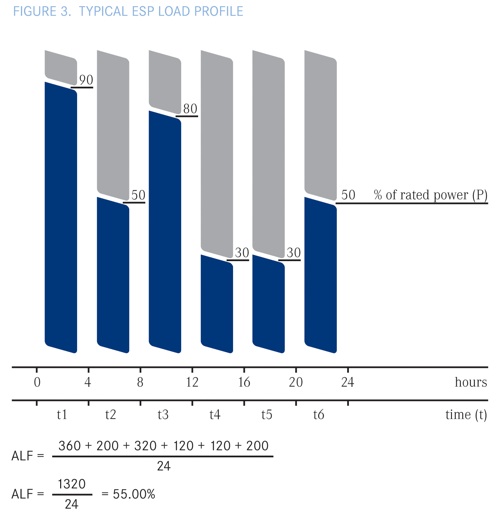
Prime-Rated Power (PRP)— A prime-rated generator set is available for an unlimited number of hours per year in a variable-load application, as long as the average load factor does not exceed 70 percent of the nameplate rating, unless the manufacturer allows a higher average load factor. This rating allows an overload capacity of 10 percent, but that additional capacity should not be used for more than one hour in every 12. The prime power rating for a given generator set is typically 10 percent lower than the standby rating. Figure 4 shows a typical load profile for a PRP-rated generator set.
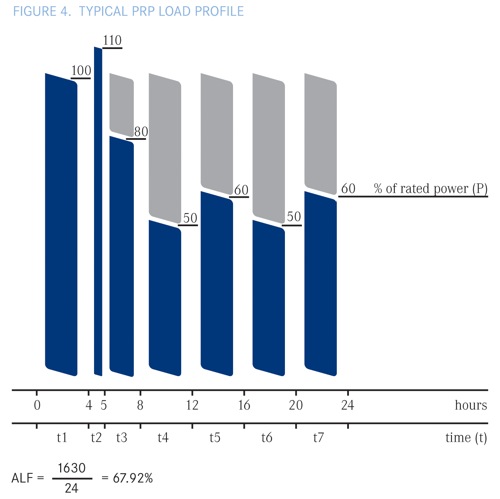
Continuous Power Rating (COP)— The continuous power rating is used for applications where there is no utility power and the generator set is relied upon for all power needs. Generator sets with this rating are capable of supplying power at a constant 100 percent of rated load for an unlimited number of hours per year. No overload capability is available for this rating. The continuous power rating for a given generator set is typically 25-30 percent lower than the standby rating. Figure 5 shows a typical load profile for a COP-rated generator set:
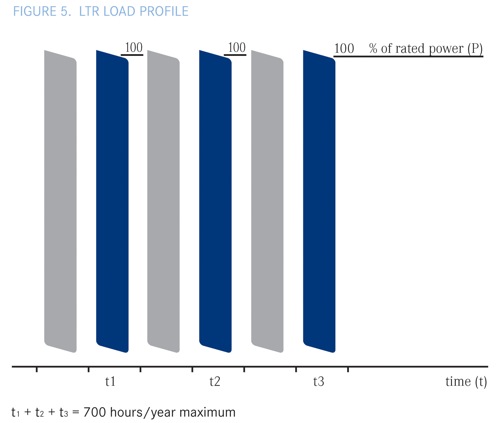
Effects of load factor on power system design
Specifying standby generator sets with a higher-than-average load factor capability can sometimes be a benefit in mission-critical applications. System designers may be able to reduce the size or number of generator sets by using units approved for 85 percent average load factor, as opposed to the 70 percent average load factor. For example, to design a standby power system to supply an average load of 11,000 kW at a 70 percent average load factor would require eight 2,000 kW generator sets. At a 70 percent average load factor rating, each generator set would be able to deliver up to a 1,400 kW average, for a total capacity of 11,200 kW over an extended outage of 24 hours or more.
8 x 2,000 kW x .70 = 11,200 kW
Using generator sets with an 85 percent average load factor capability would require only seven 2,000 kW units. Each generator set would be able to deliver up to a 1,700 kW average, for a total average of 11,900 kW over an extended outage of 24 hours or more. That amounts to an extra 2,100 kW of effective generating capacity for extended outages and a reduction by one in the number of generator sets needed.
7 x 2,000 kW x .85 = 11,900 kW
Conclusion
The load factor of any application affects the design and sizing of the standby power system, but for mission-critical applications, particular attention must be paid to load factors because of theses facilities' minimal ability to reduce their electrical loads during extended outages. While all major manufacturers of generator sets utilize ISO-8528-1 (which sets the average 24-hour load factor at 70 percent) as their standard, system designers can choose equipment that offers a higher average 24-hour load factor, which may, in turn, result in a system with smaller and/or fewer generator sets. In any case, specifiers of standby power systems for mission-critical applications need to understand average load factor and its implications for business continuity in the face of natural or man-made disasters.
About MTU Onsite Energy
MTU Onsite Energy is a leading producer of diesel-powered generator sets from 30 to 3,250 kW and natural gas-powered generator sets from 30 to 400 kW for standby, prime power and cogeneration applications. The company also provides automatic transfer switches, paralleling switchgear, controls and accessories for complete power system solutions. MTU Onsite Energy is a subsidiary of Tognum America Inc., part of the Germany-based Tognum Group. www.mtu-online.com.
About Tognum
With its two business units, Engines and Onsite Energy & Components, the Tognum Group is one of the world's leading suppliers of engines and propulsion systems for off-highway applications and of distributed energy systems. These products are based on diesel engines with up to 9,100 kilowatts (kW) power output, gas engines up to 2,150 kW and gas turbines up to 45,000 kW.
The product portfolio of the Engines business unit comprises MTU engines and propulsion systems for ships, for heavy land, rail and defense vehicles and for the oil and gas industry. The portfolio of the Onsite Energy & Components business unit includes distributed energy systems of the brand MTU Onsite Energy and fuel-injection systems from L'Orange. The energy systems comprise diesel engines for emergency standby power, prime power and continuous power, as well as cogeneration power plants based on gas engines and gas turbines that generate both power and heat.
In 2010, Tognum generated revenue of around €2.56 billion and employs more than 9,000 people. Tognum has a global manufacturing, distribution and service structure with 23 fully consolidated companies, more than 140 sales partners and over 500 authorized dealerships at approximately 1,200 locations. Since September 2011, Engine Holding GmbH, a joint venture between Daimler AG and Rolls-Royce Group plc has a majority holding in Tognum. www.tognum.com.
















